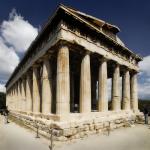|
This section contains 634 words (approx. 3 pages at 300 words per page) |

|
| c. 1500 B.C.E. | A small steatite (black soapstone) vase found at Hagia Traiada on Crete dated from this time period shows a harvest dance carved in relief. |
| c. 1300 B.C.E. | A small earthenware figurine found at Palaikastro on Crete from this time period shows women dancing in a circle around a lyre-player. |
| 544 B.C.E. | The "Festival of the Naked Boys" is organized in Sparta where Spartan youths as well as older men dance naked in the marketplace and sing hymns in honor of the dead who fell at the Battle of Thyrea, fought with Sparta's northern neighbor, Argos. |
| 534 B.C.E. | The Festival of the City Dionysia is established in Athens by the tyrant Pisistratus in which Thespis wins first prize for his "tragedy"—a dithyramb (choral song) where he impersonates the main character himself. |
| 508 B.C.E. | At... |
|
This section contains 634 words (approx. 3 pages at 300 words per page) |

|




